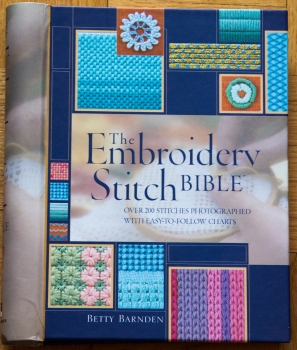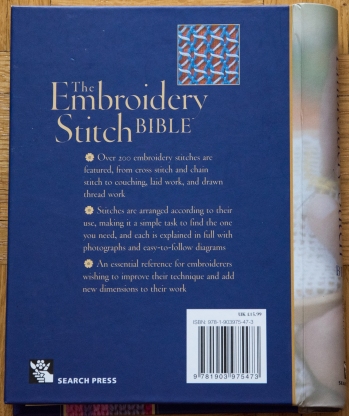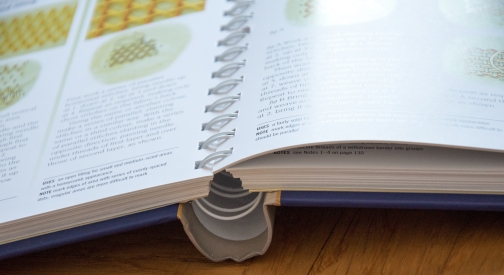Disclaimer: This post contains affiliate links meaning if you make purchases from this blog, I get a small commission. However, any recommendations and opinions are my own. For more information, please click here.
One of the great things about the spread of the Internet has been the increasing accessibility of information on even the most niche of hobbies. This is great news for crafters for very obvious reasons, but with a growing number of wonderful Youtube tutorials and online stitch tutorials, is there any place left for a hardbound stitch bible?

If the stitch guide in question is The Embroidery Stitch Bible by Betty Barnden, the answer is a resounding yes. While I don’t know any of Betty Barnden’s embroidery work itself, she is a prolific author of stitch guides, including The Crochet Stitch Bible
and its knitting equivalent, and has this down to a very fine art.
Structure
The book is split into stitches for fabric and those for canvas with some other sections at the beginning and end on general tools, transferring designs, understanding charts and finishing techniques for pieces. This isn’t really aimed at completely novice stitchers, overwhelmed with where to start and looking for a lot of guidance (if you’re looking for more of an ‘into to embroidery’ book – Sophie Long’s beautiful Mastering the Art of Embroidery might be better for you) but is, exactly as it says in the title, a reference book with hundreds of stitches for you to pursue.
What makes this book absolutely genius and far more than just stitch instructions is the ‘Stitch Selector’ at the beginning. The Stitch Selector is a photographic index of all the stitches. There is a text index at the back, if you know the name of the stitch you’re interested in, but if you’re trying to identify a stitch in someone else’s work or are looking for just the right effect for your own design, this is an amazing resource.
In the Stitch Selector, the stitches are subdivided into different kinds of stitches, like satin stitches and laid filling stitches, which is very handy when you’re trying to meet a Royal School of Needlework brief and need to think of three filling stitches to incorporate to your design! The internet may be great when you know exactly what you’re looking for, but in any other situation where you’re looking for inspiration, or to compare different stitch types, the Stitch Selector is a far more comprehensive, useful resource and, if you’re into designing your own pieces, I’d probably buy this book for the first 24 pages alone. Every time I’m working on something that isn’t strictly goldwork or some other technique, this book is always the first place I go to.

Stitch Diagrams
How good are the stitch guides then? It’s hard to rival Mary Corbet’s amazing online stitch library (she really does make excellent photo tutorials) and many people like being able to watch videos. Personally, I usually prefer written guides because I’m too impatient to listen to someone explaining what’s going on and I can refer back to a book more easily mid-stitch. Thankfully, The Embroidery Stitch Bible rewards my impatience with lovely, numbered guides that are very easy to follow.
Each stitch gets at least half a page and there is a photograph of the finished stitch – often worked in several different ways, with a diagram of the stitching process. The numbers tell you what order to do things in and there are guide lines for stitches like double chain stitch to give you an idea of what spacing you need. I sometimes would have liked some arrows to give a feel for the direction to take the needle while weaving stitches but there are written instructions for each stitch too and so far, I think I’ve been able to stitch all of the stitches I’ve tried from the book without any problems.
Each stitch comes with a notes section for some hints and tips on how to work it, alternative names and ideas of where the stitch is commonly used. Occasionally the text descriptions can feel a little brief and there could be more information on keeping stitch tension correct or perhaps common mishaps but for anything particular difficult this is usually covered in the stitch notes.
The numbering may be a little on the small side for anyone with poor eyesight but the diagrams and text should be easily readable for most. The photographs are a great creative source of inspiration in themselves and I think Betty Barnden does a heroic job of covering a huge number of stitches in enough detail that you should be able to create them yourself without too many problems. If you’re left-handed, you might feel left out as per usual, everything here is aimed at the right-handed stitcher but I feel I’m so used to this that reversing diagrams is automatic, and they’re clear enough that it’s easy to see where you might need to for your own stitching comfort.
Other Sections
Covering several hundred canvas and fabric stitches while giving them ample room for diagrams you can read takes up the majority of the book but there’s still room to squeeze in a few bonus sections at the end. There’s a terminology glossary for everything from telling your binca to evenweave apart, the incredibly helpful and comprehensive text index and also the ‘Working Practice’ section.
The Working Practice is a bit of a mish-mash of things, from a summary of embroidery techniques and some information on designing and completing your embroidery. The technique summary section is surprisingly detailed, particularly for goldwork, and actually covers how to sew plate, do padding and some general advice for working with precious threads and what the many kinds of goldwork threads are.
There are some lovely example pieces too, including a photo of an amazing blackwork rooster that just looks hilarious and a canvaswork goldfish that I’m completely in love with. If you’re serious about a ‘specialised’ technique like quilting or whitework, then it’s probably better to pick up a text on the subject, like the generally great RSN Stitch Guides, but there’s definitely enough information on these techniques here to get you started on a kit or exploring on your own if you’re more confident.
I like the Finishing Touches section as it outlines a few different ways of finishing your work, including pressing, blocking, adding borders and good old traditional embroidery mounting. There are instructions for how to do all of these, but the instructions are rather terse so if you are a complete beginner it would be difficult to work out how to do it from this text alone. There are again some more bonus parts such as a really cute piece on making bound and knotted tassels, adding fringes and different kinds of cord.

Construction
There is a new revised edition of the Embroidery Stitch Bible as of December 2017 (the version photographed in this review is the previous edition) but it looks like they’ve removed the spiral binding so you might want to see if you can get an old copy while you still can! It has that annoying creakiness that comes with all spiral-bound books but my copy has had a very hard life of travel, still looks nearly new, and sits nearly perfectly flat as required.
Recommended?
Absolutely – The Embroidery Stitch Bible really packs a punch in terms of the amount of information it manages to convey in a book sufficiently compactly sized you won’t regret lugging it to any of your classes. Admittedly, not every stitch in the universe is in here, so don’t expect to find some of the complex Brazilian embroidery stitches, but nearly every other stitch for generic surface embroidery (and there is quite a lot on general couching advice that the goldwork addicts will enjoy).
I think this is a great book for beginner and advanced stitcher alike. The beginner will get lots of practical help and clear guidance on how to do stitches, as well as a glimpse into the mesmerising world of techniques and ideas out there. The more advanced will get lots of different ideas of working stitches, incorporating them in designs, some hints and tips for better stitch quality and pages and pages of lovely stitch photographs.
Details
Author: Betty Barnden
Publisher: Search Press
Pages: 256
Size: 17.5 x 21 x 3 cm
Weight: 490 g
That is on my to do someday list – learn more embroidery stitches!
LikeLiked by 1 person
I think my goal is being able to actually remember some of the ones I know!
LikeLike
I’ve also got this book, but it never seems to be one of my more regular references for some reason. I think I just prefer the way the stitches are photographed in other books. But it is excellent for the range of stitches it has – I’m not sure any other book has such a range!
LikeLiked by 1 person
I can understand that – the more specialised texts tend to show a lot more detail but I do like the diagrams for most of the stitches in this one and appreciate having everything in one portable book!
LikeLiked by 1 person
[…] I hope this will help and, as I have a dreadful memory for stitch orders, I can just consulted the Embroidery Stitch Bible then and focus on stitching, not getting lost in what to […]
LikeLike
[…] the silk ribbon and I had to really drag it through the foot opening and a few points. I remember one teacher mentioning the folly of trying to do ribbon embroidery with anything other than silk ribbon and I […]
LikeLike
[…] have an atrocious memory for stitching instructions (there is a reason I love the Embroidery Stitch Bible so much and anyone who creates kits including stitch guides) but this one felt a little odd. For […]
LikeLike
[…] alone! How anyone could remember that many I don’t know (there’s a reason I keep my copy of the Embroidery Stitch Bible […]
LikeLike